

Compact Muon Solenoid
LHC, CERN
| CMS-HIG-17-024 ; CERN-EP-2018-089 | ||
| Search for an exotic decay of the Higgs boson to a pair of light pseudoscalars in the final state with two b quarks and two $\tau$ leptons in proton-proton collisions at $\sqrt{s} = $ 13 TeV | ||
| CMS Collaboration | ||
| 25 May 2018 | ||
| Phys. Lett. B 785 (2018) 462 | ||
| Abstract: A search for an exotic decay of the Higgs boson to a pair of light pseudoscalar bosons is performed for the first time in the final state with two b quarks and two $\tau$ leptons. The search is motivated in the context of models of physics beyond the standard model (SM), such as two Higgs doublet models extended with a complex scalar singlet (2HDM+S), which include the next-to-minimal supersymmetric SM (NMSSM). The results are based on a data set of proton-proton collisions corresponding to an integrated luminosity of 35.9 fb$^{-1}$, accumulated by the CMS experiment at the LHC in 2016 at a center-of-mass energy of 13 TeV. Masses of the pseudoscalar boson between 15 and 60 GeV are probed, and no excess of events above the SM expectation is observed. Upper limits between 3 and 12% are set on the branching fraction ${\mathcal{B}({{{\mathrm{h}}\to{\mathrm{a}\mathrm{a}}\to2\tau2\mathrm{b}}}} )$ assuming the SM production of the Higgs boson. Upper limits are also set on the branching fraction of the Higgs boson to two light pseudoscalar bosons in different 2HDM+S scenarios. Assuming the SM production cross section for the Higgs boson, the upper limit on this quantity is as low as 20% for a mass of the pseudoscalar of 40 GeV in the NMSSM. | ||
| Links: e-print arXiv:1805.10191 [hep-ex] (PDF) ; CDS record ; inSPIRE record ; HepData record ; CADI line (restricted) ; | ||
| Figures & Tables | Summary | Additional Figures | References | CMS Publications |
|---|
| Figures | |

png pdf |
Figure 1:
Predicted ${\mathcal {B}({{\mathrm {a}} {{\mathrm {a}} \to {{\mathrm {b}} {{\mathrm {b}} {\tau} {\tau}}}}})}$ for $ {m_{{{\mathrm {a}}}}} = $ 40 GeV in the different models of 2HDM+S, for various values of $\tan\beta $. The picture is essentially the same for all ${m_{{{\mathrm {a}}}}}$ hypotheses considered in this Letter. The branching fractions are computed following the formulas of Ref. [15]. |
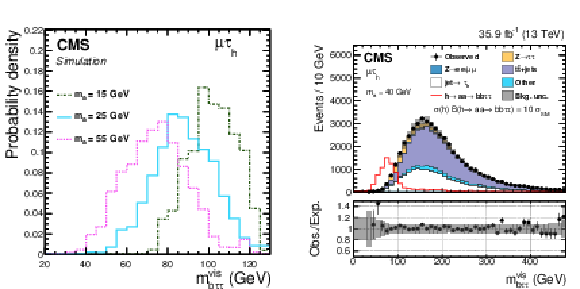
png pdf |
Figure 2:
Visible invariant mass of the leptons and the leading b jet, ${m_{{{\mathrm {b}} {\tau} {\tau}}^{\text {vis}}}}$, after the baseline selection, in the $ {{\mu}} {{\tau} _{\mathrm {h}}} $ final state, for the signal with different mass hypotheses (left). Distribution of ${m_{{{\mathrm {b}} {\tau} {\tau}}^{\text {vis}}}}$ in the $ {{\mu}} {{\tau} _{\mathrm {h}}} $ final state (right). The "$\textrm {jet}\to {{\tau} _{\mathrm {h}}} $" contribution includes all events with a jet misidentified as a $ {{\tau} _{\mathrm {h}}} $ candidate, whereas the rest of background contributions only include events where the reconstructed $ {{\tau} _{\mathrm {h}}} $ corresponds to a $ {{\tau} _{\mathrm {h}}}$, a muon, or an electron, at the generator level. The "Other" contribution includes events from single top quark, diboson, and SM Higgs boson processes. The signal histogram corresponds to 10 times the SM production cross section for $ {{\mathrm {g}} {{\mathrm {g}} {{\mathrm {h}}}}} $, VBF, and Vh processes, and assumes ${\mathcal {B}({{{{\mathrm {h}}}\to {{{\mathrm {a}} {{\mathrm {a}}}\to 2 {\tau}2{{{\mathrm {b}}}}}}}})}= $ 100%. |
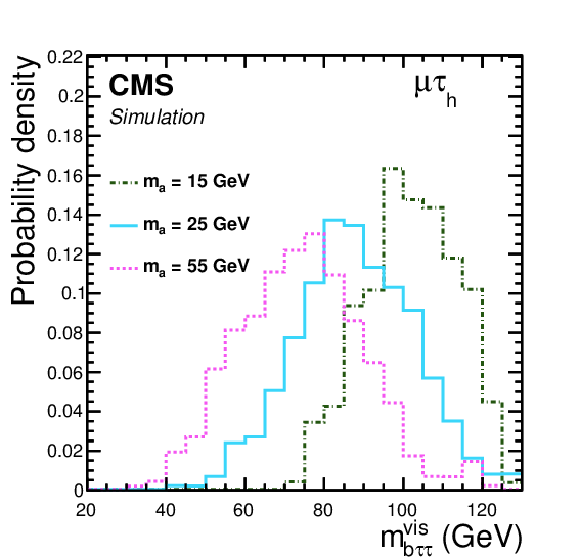
png pdf |
Figure 2-a:
Visible invariant mass of the leptons and the leading b jet, ${m_{{{\mathrm {b}} {\tau} {\tau}}^{\text {vis}}}}$, after the baseline selection, in the $ {{\mu}} {{\tau} _{\mathrm {h}}} $ final state, for the signal with different mass hypotheses. |
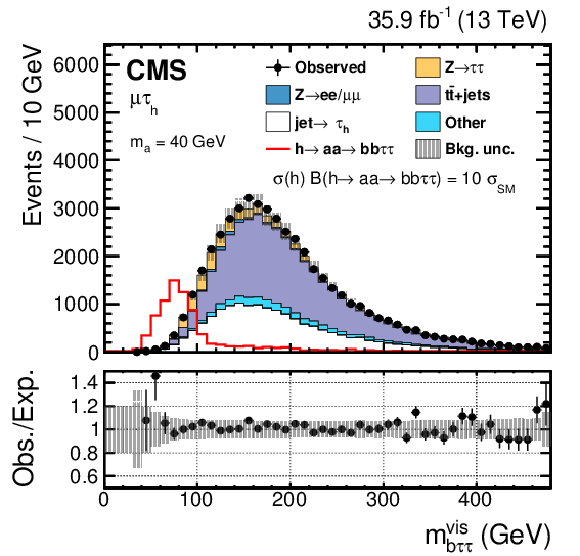
png pdf |
Figure 2-b:
Distribution of ${m_{{{\mathrm {b}} {\tau} {\tau}}^{\text {vis}}}}$ in the $ {{\mu}} {{\tau} _{\mathrm {h}}} $ final state. The "$\textrm {jet}\to {{\tau} _{\mathrm {h}}} $" contribution includes all events with a jet misidentified as a $ {{\tau} _{\mathrm {h}}} $ candidate, whereas the rest of background contributions only include events where the reconstructed $ {{\tau} _{\mathrm {h}}} $ corresponds to a $ {{\tau} _{\mathrm {h}}}$, a muon, or an electron, at the generator level. The "Other" contribution includes events from single top quark, diboson, and SM Higgs boson processes. The signal histogram corresponds to 10 times the SM production cross section for $ {{\mathrm {g}} {{\mathrm {g}} {{\mathrm {h}}}}} $, VBF, and Vh processes, and assumes ${\mathcal {B}({{{{\mathrm {h}}}\to {{{\mathrm {a}} {{\mathrm {a}}}\to 2 {\tau}2{{{\mathrm {b}}}}}}}})}= $ 100%. |
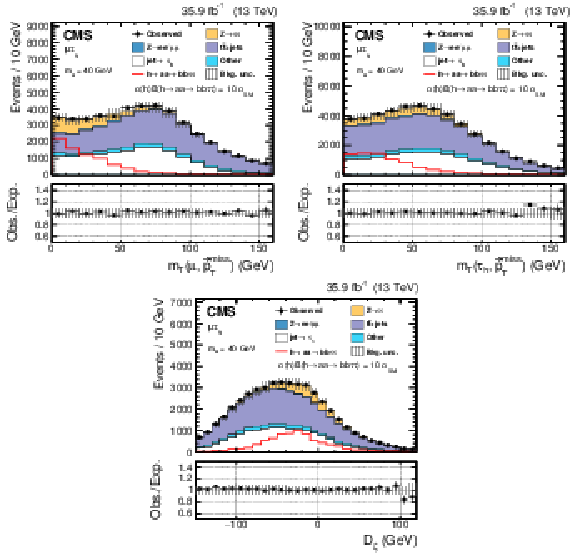
png pdf |
Figure 3:
Distributions of $ {m_{{\mathrm {T}}} ({{\mu}}, {{{\vec{p}}_{{\mathrm {T}}^{\text {miss}}}}}})$ (top left), $ {m_{{\mathrm {T}}} ({{\tau} _{\mathrm {h}}, {{{\vec{p}}_{{\mathrm {T}}^{\text {miss}}}}}})}$ (top right), and $D_\zeta $ (bottom) in the $ {{\mu}} {{\tau} _{\mathrm {h}}} $ final state before the $ {m_{{{\mathrm {b}} {\tau} {\tau}}^{\text {vis}}}} $-based categorization. The "$\textrm {jet}\to {{\tau} _{\mathrm {h}}} $" contribution includes all events with a jet misidentified as a $ {{\tau} _{\mathrm {h}}} $ candidate, whereas the rest of background contributions only include events where the reconstructed $ {{\tau} _{\mathrm {h}}} $ corresponds to a $ {{\tau} _{\mathrm {h}}} $, a muon, or an electron, at the generator level. The "Other" contribution includes events from single top quark, diboson, and SM Higgs boson processes. The signal histogram corresponds to 10 times the SM production cross section for $ {{\mathrm {g}} {{\mathrm {g}} {{\mathrm {h}}}}} $, VBF, and Vh processes, and assumes ${\mathcal {B}({{{{\mathrm {h}}}\to {{{\mathrm {a}} {{\mathrm {a}}}\to 2 {\tau}2{{{\mathrm {b}}}}}}}})}= $ 100%. |
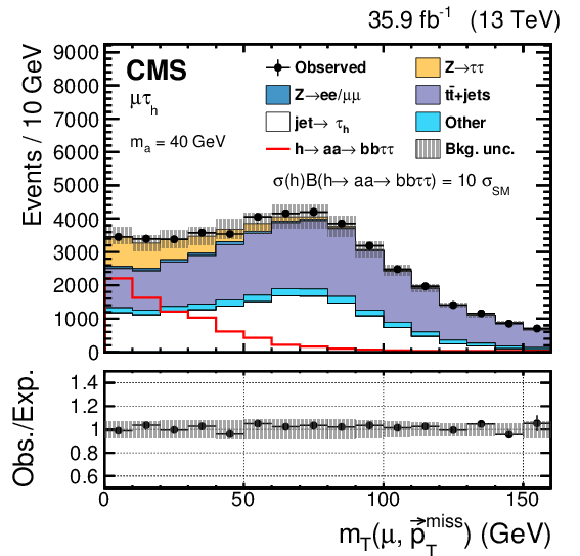
png pdf |
Figure 3-a:
Distribution of $ {m_{{\mathrm {T}}} ({{\mu}}, {{{\vec{p}}_{{\mathrm {T}}^{\text {miss}}}}}})$ in the $ {{\mu}} {{\tau} _{\mathrm {h}}} $ final state before the $ {m_{{{\mathrm {b}} {\tau} {\tau}}^{\text {vis}}}} $-based categorization. The "$\textrm {jet}\to {{\tau} _{\mathrm {h}}} $" contribution includes all events with a jet misidentified as a $ {{\tau} _{\mathrm {h}}} $ candidate, whereas the rest of background contributions only include events where the reconstructed $ {{\tau} _{\mathrm {h}}} $ corresponds to a $ {{\tau} _{\mathrm {h}}} $, a muon, or an electron, at the generator level. The "Other" contribution includes events from single top quark, diboson, and SM Higgs boson processes. The signal histogram corresponds to 10 times the SM production cross section for $ {{\mathrm {g}} {{\mathrm {g}} {{\mathrm {h}}}}} $, VBF, and Vh processes, and assumes ${\mathcal {B}({{{{\mathrm {h}}}\to {{{\mathrm {a}} {{\mathrm {a}}}\to 2 {\tau}2{{{\mathrm {b}}}}}}}})}= $ 100%. |

png pdf |
Figure 3-b:
Distribution of $ {m_{{\mathrm {T}}} ({{\tau} _{\mathrm {h}}, {{{\vec{p}}_{{\mathrm {T}}^{\text {miss}}}}}})}$ in the $ {{\mu}} {{\tau} _{\mathrm {h}}} $ final state before the $ {m_{{{\mathrm {b}} {\tau} {\tau}}^{\text {vis}}}} $-based categorization. The "$\textrm {jet}\to {{\tau} _{\mathrm {h}}} $" contribution includes all events with a jet misidentified as a $ {{\tau} _{\mathrm {h}}} $ candidate, whereas the rest of background contributions only include events where the reconstructed $ {{\tau} _{\mathrm {h}}} $ corresponds to a $ {{\tau} _{\mathrm {h}}} $, a muon, or an electron, at the generator level. The "Other" contribution includes events from single top quark, diboson, and SM Higgs boson processes. The signal histogram corresponds to 10 times the SM production cross section for $ {{\mathrm {g}} {{\mathrm {g}} {{\mathrm {h}}}}} $, VBF, and Vh processes, and assumes ${\mathcal {B}({{{{\mathrm {h}}}\to {{{\mathrm {a}} {{\mathrm {a}}}\to 2 {\tau}2{{{\mathrm {b}}}}}}}})}= $ 100%. |
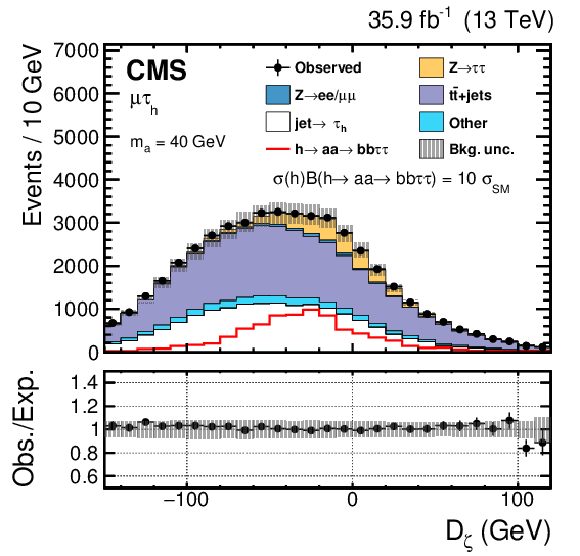
png pdf |
Figure 3-c:
Distribution of $D_\zeta $ in the $ {{\mu}} {{\tau} _{\mathrm {h}}} $ final state before the $ {m_{{{\mathrm {b}} {\tau} {\tau}}^{\text {vis}}}} $-based categorization. The "$\textrm {jet}\to {{\tau} _{\mathrm {h}}} $" contribution includes all events with a jet misidentified as a $ {{\tau} _{\mathrm {h}}} $ candidate, whereas the rest of background contributions only include events where the reconstructed $ {{\tau} _{\mathrm {h}}} $ corresponds to a $ {{\tau} _{\mathrm {h}}} $, a muon, or an electron, at the generator level. The "Other" contribution includes events from single top quark, diboson, and SM Higgs boson processes. The signal histogram corresponds to 10 times the SM production cross section for $ {{\mathrm {g}} {{\mathrm {g}} {{\mathrm {h}}}}} $, VBF, and Vh processes, and assumes ${\mathcal {B}({{{{\mathrm {h}}}\to {{{\mathrm {a}} {{\mathrm {a}}}\to 2 {\tau}2{{{\mathrm {b}}}}}}}})}= $ 100%. |

png pdf |
Figure 4:
Distributions of $ {m_{{\tau} {\tau}}^{\text {vis}}} $ in the four categories of the $ {{\mathrm {e}} {{\mu}}}$ channel. The "Other" contribution includes events from single top quark, diboson, SM Higgs boson, and W+jets productions. The signal histogram corresponds to the SM production cross section for $ {{\mathrm {g}} {{\mathrm {g}} {{\mathrm {h}}}}} $, VBF, and Vh processes, and assumes ${\mathcal {B}({{{{\mathrm {h}}}\to {{{\mathrm {a}} {{\mathrm {a}}}\to 2 {\tau}2{{{\mathrm {b}}}}}}}})}= $ 10%. The normalization of the predicted background distributions corresponds to the result of the global fit. |

png pdf |
Figure 4-a:
Distribution of $ {m_{{\tau} {\tau}}^{\text {vis}}} $ in one of four categories of the $ {{\mathrm {e}} {{\mu}}}$ channel. The "Other" contribution includes events from single top quark, diboson, SM Higgs boson, and W+jets productions. The signal histogram corresponds to the SM production cross section for $ {{\mathrm {g}} {{\mathrm {g}} {{\mathrm {h}}}}} $, VBF, and Vh processes, and assumes ${\mathcal {B}({{{{\mathrm {h}}}\to {{{\mathrm {a}} {{\mathrm {a}}}\to 2 {\tau}2{{{\mathrm {b}}}}}}}})}= $ 10%. The normalization of the predicted background distributions corresponds to the result of the global fit. |
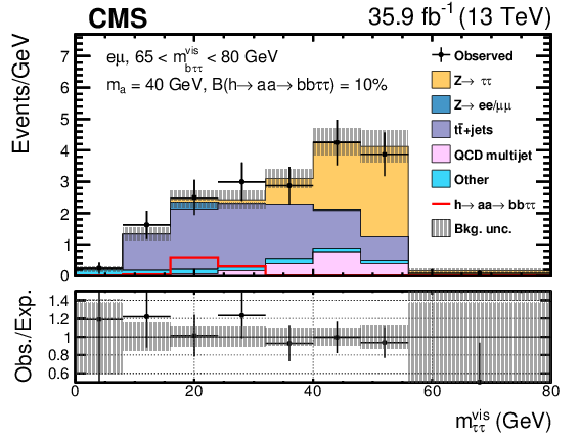
png pdf |
Figure 4-b:
Distribution of $ {m_{{\tau} {\tau}}^{\text {vis}}} $ in one of four categories of the $ {{\mathrm {e}} {{\mu}}}$ channel. The "Other" contribution includes events from single top quark, diboson, SM Higgs boson, and W+jets productions. The signal histogram corresponds to the SM production cross section for $ {{\mathrm {g}} {{\mathrm {g}} {{\mathrm {h}}}}} $, VBF, and Vh processes, and assumes ${\mathcal {B}({{{{\mathrm {h}}}\to {{{\mathrm {a}} {{\mathrm {a}}}\to 2 {\tau}2{{{\mathrm {b}}}}}}}})}= $ 10%. The normalization of the predicted background distributions corresponds to the result of the global fit. |

png pdf |
Figure 4-c:
Distribution of $ {m_{{\tau} {\tau}}^{\text {vis}}} $ in one of four categories of the $ {{\mathrm {e}} {{\mu}}}$ channel. The "Other" contribution includes events from single top quark, diboson, SM Higgs boson, and W+jets productions. The signal histogram corresponds to the SM production cross section for $ {{\mathrm {g}} {{\mathrm {g}} {{\mathrm {h}}}}} $, VBF, and Vh processes, and assumes ${\mathcal {B}({{{{\mathrm {h}}}\to {{{\mathrm {a}} {{\mathrm {a}}}\to 2 {\tau}2{{{\mathrm {b}}}}}}}})}= $ 10%. The normalization of the predicted background distributions corresponds to the result of the global fit. |

png pdf |
Figure 4-d:
Distribution of $ {m_{{\tau} {\tau}}^{\text {vis}}} $ in one of four categories of the $ {{\mathrm {e}} {{\mu}}}$ channel. The "Other" contribution includes events from single top quark, diboson, SM Higgs boson, and W+jets productions. The signal histogram corresponds to the SM production cross section for $ {{\mathrm {g}} {{\mathrm {g}} {{\mathrm {h}}}}} $, VBF, and Vh processes, and assumes ${\mathcal {B}({{{{\mathrm {h}}}\to {{{\mathrm {a}} {{\mathrm {a}}}\to 2 {\tau}2{{{\mathrm {b}}}}}}}})}= $ 10%. The normalization of the predicted background distributions corresponds to the result of the global fit. |
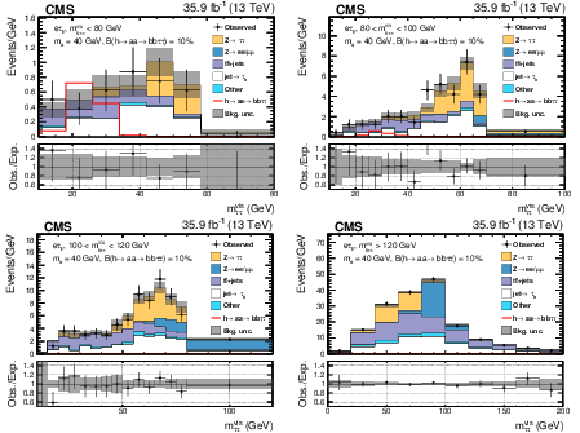
png pdf |
Figure 5:
Distributions of $ {m_{{\tau} {\tau}}^{\text {vis}}} $ in the four categories of the $ {{\mathrm {e}} {{\tau} _{\mathrm {h}}}} $ channel. The "$\textrm {jet}\to {{\tau} _{\mathrm {h}}} $" contribution includes all events with a jet misidentified as a $ {{\tau} _{\mathrm {h}}} $ candidate, whereas the rest of background contributions only include events where the reconstructed $ {{\tau} _{\mathrm {h}}} $ corresponds to a $ {{\tau} _{\mathrm {h}}} $, a muon, or an electron, at the generator level. The "Other" contribution includes events from single top quark, diboson, and SM Higgs boson processes. The signal histogram corresponds to the SM production cross section for $ {{\mathrm {g}} {{\mathrm {g}} {{\mathrm {h}}}}} $, VBF, and Vh processes, and assumes ${\mathcal {B}({{{{\mathrm {h}}}\to {{{\mathrm {a}} {{\mathrm {a}}}\to 2 {\tau}2{{{\mathrm {b}}}}}}}})}= $ 10%. The normalization of the predicted background distributions corresponds to the result of the global fit. |
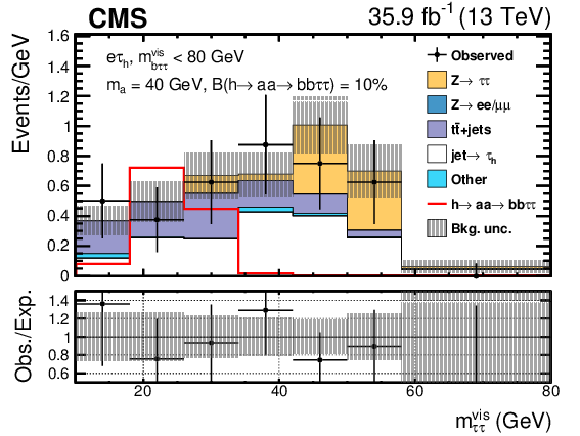
png pdf |
Figure 5-a:
Distributionsof $ {m_{{\tau} {\tau}}^{\text {vis}}} $ in one of the four categories of the $ {{\mathrm {e}} {{\tau} _{\mathrm {h}}}} $ channel. The "$\textrm {jet}\to {{\tau} _{\mathrm {h}}} $" contribution includes all events with a jet misidentified as a $ {{\tau} _{\mathrm {h}}} $ candidate, whereas the rest of background contributions only include events where the reconstructed $ {{\tau} _{\mathrm {h}}} $ corresponds to a $ {{\tau} _{\mathrm {h}}} $, a muon, or an electron, at the generator level. The "Other" contribution includes events from single top quark, diboson, and SM Higgs boson processes. The signal histogram corresponds to the SM production cross section for $ {{\mathrm {g}} {{\mathrm {g}} {{\mathrm {h}}}}} $, VBF, and Vh processes, and assumes ${\mathcal {B}({{{{\mathrm {h}}}\to {{{\mathrm {a}} {{\mathrm {a}}}\to 2 {\tau}2{{{\mathrm {b}}}}}}}})}= $ 10%. The normalization of the predicted background distributions corresponds to the result of the global fit. |
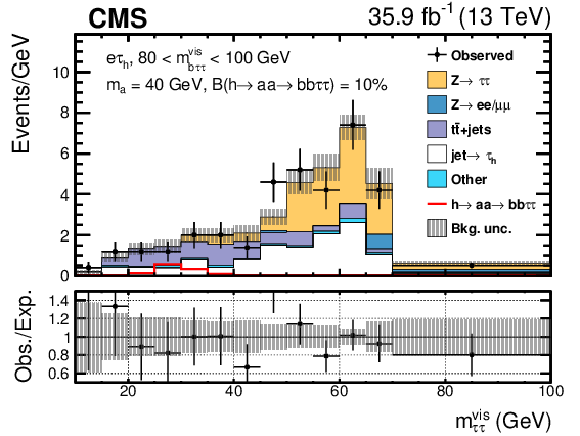
png pdf |
Figure 5-b:
Distributionsof $ {m_{{\tau} {\tau}}^{\text {vis}}} $ in one of the four categories of the $ {{\mathrm {e}} {{\tau} _{\mathrm {h}}}} $ channel. The "$\textrm {jet}\to {{\tau} _{\mathrm {h}}} $" contribution includes all events with a jet misidentified as a $ {{\tau} _{\mathrm {h}}} $ candidate, whereas the rest of background contributions only include events where the reconstructed $ {{\tau} _{\mathrm {h}}} $ corresponds to a $ {{\tau} _{\mathrm {h}}} $, a muon, or an electron, at the generator level. The "Other" contribution includes events from single top quark, diboson, and SM Higgs boson processes. The signal histogram corresponds to the SM production cross section for $ {{\mathrm {g}} {{\mathrm {g}} {{\mathrm {h}}}}} $, VBF, and Vh processes, and assumes ${\mathcal {B}({{{{\mathrm {h}}}\to {{{\mathrm {a}} {{\mathrm {a}}}\to 2 {\tau}2{{{\mathrm {b}}}}}}}})}= $ 10%. The normalization of the predicted background distributions corresponds to the result of the global fit. |
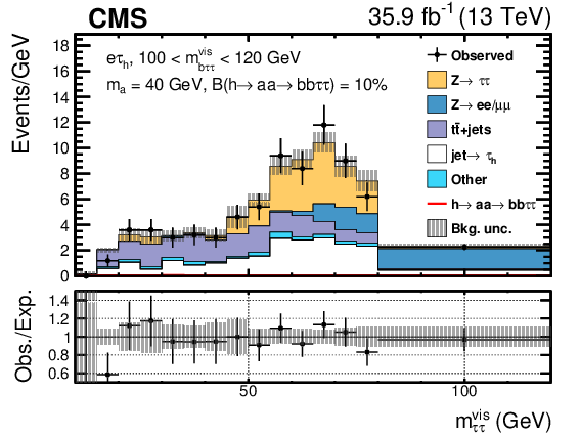
png pdf |
Figure 5-c:
Distributionsof $ {m_{{\tau} {\tau}}^{\text {vis}}} $ in one of the four categories of the $ {{\mathrm {e}} {{\tau} _{\mathrm {h}}}} $ channel. The "$\textrm {jet}\to {{\tau} _{\mathrm {h}}} $" contribution includes all events with a jet misidentified as a $ {{\tau} _{\mathrm {h}}} $ candidate, whereas the rest of background contributions only include events where the reconstructed $ {{\tau} _{\mathrm {h}}} $ corresponds to a $ {{\tau} _{\mathrm {h}}} $, a muon, or an electron, at the generator level. The "Other" contribution includes events from single top quark, diboson, and SM Higgs boson processes. The signal histogram corresponds to the SM production cross section for $ {{\mathrm {g}} {{\mathrm {g}} {{\mathrm {h}}}}} $, VBF, and Vh processes, and assumes ${\mathcal {B}({{{{\mathrm {h}}}\to {{{\mathrm {a}} {{\mathrm {a}}}\to 2 {\tau}2{{{\mathrm {b}}}}}}}})}= $ 10%. The normalization of the predicted background distributions corresponds to the result of the global fit. |
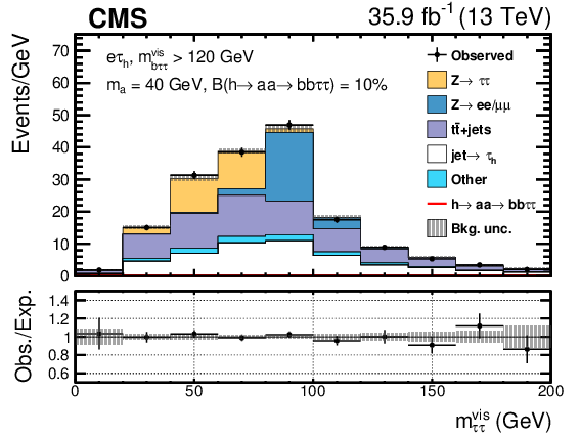
png pdf |
Figure 5-d:
Distributionsof $ {m_{{\tau} {\tau}}^{\text {vis}}} $ in one of the four categories of the $ {{\mathrm {e}} {{\tau} _{\mathrm {h}}}} $ channel. The "$\textrm {jet}\to {{\tau} _{\mathrm {h}}} $" contribution includes all events with a jet misidentified as a $ {{\tau} _{\mathrm {h}}} $ candidate, whereas the rest of background contributions only include events where the reconstructed $ {{\tau} _{\mathrm {h}}} $ corresponds to a $ {{\tau} _{\mathrm {h}}} $, a muon, or an electron, at the generator level. The "Other" contribution includes events from single top quark, diboson, and SM Higgs boson processes. The signal histogram corresponds to the SM production cross section for $ {{\mathrm {g}} {{\mathrm {g}} {{\mathrm {h}}}}} $, VBF, and Vh processes, and assumes ${\mathcal {B}({{{{\mathrm {h}}}\to {{{\mathrm {a}} {{\mathrm {a}}}\to 2 {\tau}2{{{\mathrm {b}}}}}}}})}= $ 10%. The normalization of the predicted background distributions corresponds to the result of the global fit. |
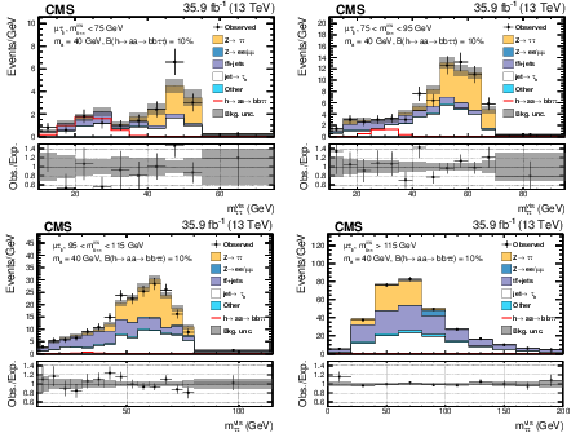
png pdf |
Figure 6:
Distributions of $ {m_{{\tau} {\tau}}^{\text {vis}}} $ in the four categories of the $ {{\mu}} {{\tau} _{\mathrm {h}}} $ channel. The "$\textrm {jet}\to {{\tau} _{\mathrm {h}}}$" contribution includes all events with a jet misidentified as a $ {{\tau} _{\mathrm {h}}} $ candidate, whereas the rest of background contributions only include events where the reconstructed $ {{\tau} _{\mathrm {h}}} $ corresponds to a $ {{\tau} _{\mathrm {h}}} $, a muon, or an electron, at the generator level. The "Other" contribution includes events from single top quark, diboson, and SM Higgs boson processes. The signal histogram corresponds to the SM production cross section for $ {{\mathrm {g}} {{\mathrm {g}} {{\mathrm {h}}}}} $, VBF, and Vh processes, and assumes ${\mathcal {B}({{{{\mathrm {h}}}\to {{{\mathrm {a}} {{\mathrm {a}}}\to 2 {\tau}2{{{\mathrm {b}}}}}}}})}= $ 10%. The normalization of the predicted background distributions corresponds to the result of the global fit. |

png pdf |
Figure 6-a:
Distribution of $ {m_{{\tau} {\tau}}^{\text {vis}}} $ in one of the four categories of the $ {{\mu}} {{\tau} _{\mathrm {h}}} $ channel. The "$\textrm {jet}\to {{\tau} _{\mathrm {h}}}$" contribution includes all events with a jet misidentified as a $ {{\tau} _{\mathrm {h}}} $ candidate, whereas the rest of background contributions only include events where the reconstructed $ {{\tau} _{\mathrm {h}}} $ corresponds to a $ {{\tau} _{\mathrm {h}}} $, a muon, or an electron, at the generator level. The "Other" contribution includes events from single top quark, diboson, and SM Higgs boson processes. The signal histogram corresponds to the SM production cross section for $ {{\mathrm {g}} {{\mathrm {g}} {{\mathrm {h}}}}} $, VBF, and Vh processes, and assumes ${\mathcal {B}({{{{\mathrm {h}}}\to {{{\mathrm {a}} {{\mathrm {a}}}\to 2 {\tau}2{{{\mathrm {b}}}}}}}})}= $ 10%. The normalization of the predicted background distributions corresponds to the result of the global fit. |
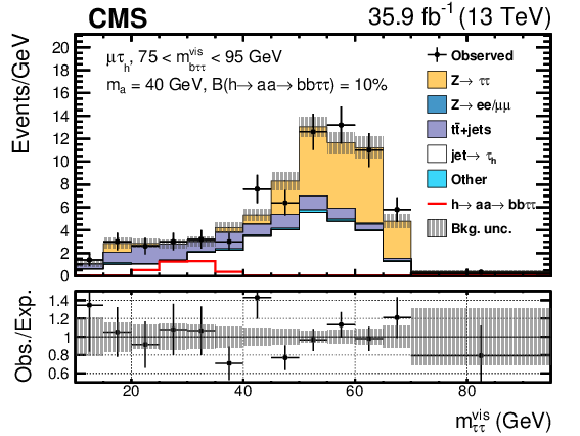
png pdf |
Figure 6-b:
Distribution of $ {m_{{\tau} {\tau}}^{\text {vis}}} $ in one of the four categories of the $ {{\mu}} {{\tau} _{\mathrm {h}}} $ channel. The "$\textrm {jet}\to {{\tau} _{\mathrm {h}}}$" contribution includes all events with a jet misidentified as a $ {{\tau} _{\mathrm {h}}} $ candidate, whereas the rest of background contributions only include events where the reconstructed $ {{\tau} _{\mathrm {h}}} $ corresponds to a $ {{\tau} _{\mathrm {h}}} $, a muon, or an electron, at the generator level. The "Other" contribution includes events from single top quark, diboson, and SM Higgs boson processes. The signal histogram corresponds to the SM production cross section for $ {{\mathrm {g}} {{\mathrm {g}} {{\mathrm {h}}}}} $, VBF, and Vh processes, and assumes ${\mathcal {B}({{{{\mathrm {h}}}\to {{{\mathrm {a}} {{\mathrm {a}}}\to 2 {\tau}2{{{\mathrm {b}}}}}}}})}= $ 10%. The normalization of the predicted background distributions corresponds to the result of the global fit. |
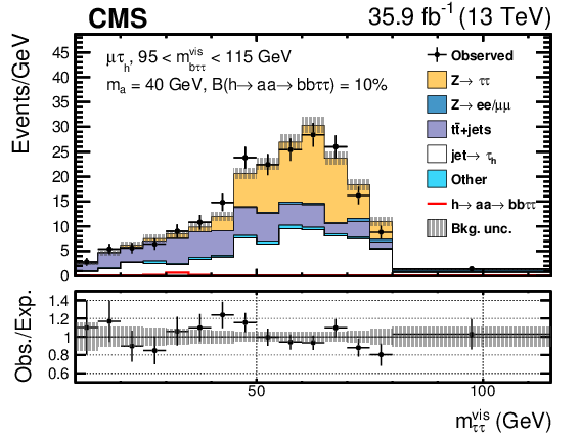
png pdf |
Figure 6-c:
Distribution of $ {m_{{\tau} {\tau}}^{\text {vis}}} $ in one of the four categories of the $ {{\mu}} {{\tau} _{\mathrm {h}}} $ channel. The "$\textrm {jet}\to {{\tau} _{\mathrm {h}}}$" contribution includes all events with a jet misidentified as a $ {{\tau} _{\mathrm {h}}} $ candidate, whereas the rest of background contributions only include events where the reconstructed $ {{\tau} _{\mathrm {h}}} $ corresponds to a $ {{\tau} _{\mathrm {h}}} $, a muon, or an electron, at the generator level. The "Other" contribution includes events from single top quark, diboson, and SM Higgs boson processes. The signal histogram corresponds to the SM production cross section for $ {{\mathrm {g}} {{\mathrm {g}} {{\mathrm {h}}}}} $, VBF, and Vh processes, and assumes ${\mathcal {B}({{{{\mathrm {h}}}\to {{{\mathrm {a}} {{\mathrm {a}}}\to 2 {\tau}2{{{\mathrm {b}}}}}}}})}= $ 10%. The normalization of the predicted background distributions corresponds to the result of the global fit. |
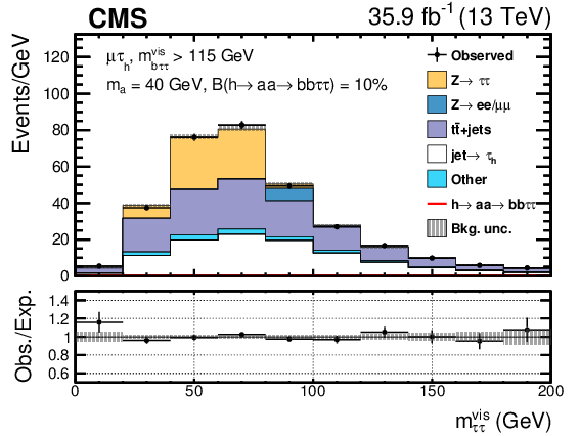
png pdf |
Figure 6-d:
Distribution of $ {m_{{\tau} {\tau}}^{\text {vis}}} $ in one of the four categories of the $ {{\mu}} {{\tau} _{\mathrm {h}}} $ channel. The "$\textrm {jet}\to {{\tau} _{\mathrm {h}}}$" contribution includes all events with a jet misidentified as a $ {{\tau} _{\mathrm {h}}} $ candidate, whereas the rest of background contributions only include events where the reconstructed $ {{\tau} _{\mathrm {h}}} $ corresponds to a $ {{\tau} _{\mathrm {h}}} $, a muon, or an electron, at the generator level. The "Other" contribution includes events from single top quark, diboson, and SM Higgs boson processes. The signal histogram corresponds to the SM production cross section for $ {{\mathrm {g}} {{\mathrm {g}} {{\mathrm {h}}}}} $, VBF, and Vh processes, and assumes ${\mathcal {B}({{{{\mathrm {h}}}\to {{{\mathrm {a}} {{\mathrm {a}}}\to 2 {\tau}2{{{\mathrm {b}}}}}}}})}= $ 10%. The normalization of the predicted background distributions corresponds to the result of the global fit. |

png pdf |
Figure 7:
Expected and observed 95% CL limits on $(\sigma ({{\mathrm {h}})/\sigma _\textrm {SM}) {\mathcal {B}({{{{\mathrm {h}}}\to {{{\mathrm {a}} {{\mathrm {a}}}\to 2 {\tau}2{{{\mathrm {b}}}}}}}})}}$ in%. The $ {{\mathrm {e}} {{\mu}}}$ results are shown in the top left panel, $ {{\mathrm {e}} {{\tau} _{\mathrm {h}}}} $ in the top right, $ {{\mu}} {{\tau} _{\mathrm {h}}} $ in the bottom left, and the combination in the bottom right. The inner (green) band and the outer (yellow) band indicate the regions containing 68 and 95%, respectively, of the distribution of limits expected under the background-only hypothesis. |

png pdf |
Figure 7-a:
Expected and observed 95% CL limits on $(\sigma ({{\mathrm {h}})/\sigma _\textrm {SM}) {\mathcal {B}({{{{\mathrm {h}}}\to {{{\mathrm {a}} {{\mathrm {a}}}\to 2 {\tau}2{{{\mathrm {b}}}}}}}})}}$ in% ($ {{\mathrm {e}} {{\mu}}}$). The inner (green) band and the outer (yellow) band indicate the regions containing 68 and 95%, respectively, of the distribution of limits expected under the background-only hypothesis. |
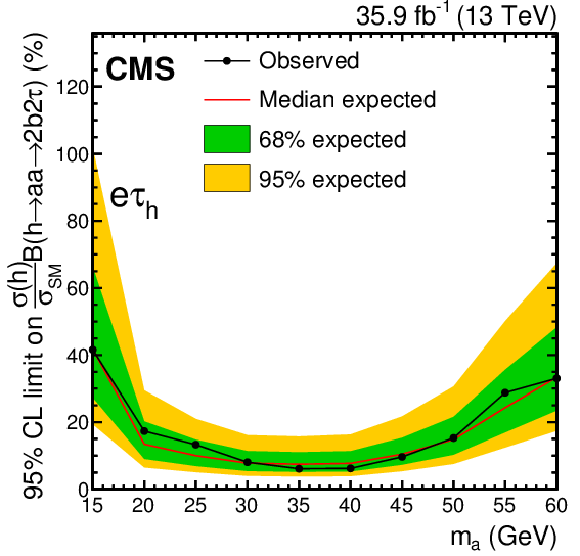
png pdf |
Figure 7-b:
Expected and observed 95% CL limits on $(\sigma ({{\mathrm {h}})/\sigma _\textrm {SM}) {\mathcal {B}({{{{\mathrm {h}}}\to {{{\mathrm {a}} {{\mathrm {a}}}\to 2 {\tau}2{{{\mathrm {b}}}}}}}})}}$ in% ($ {{\mathrm {e}} {{\tau} _{\mathrm {h}}}} $). The inner (green) band and the outer (yellow) band indicate the regions containing 68 and 95%, respectively, of the distribution of limits expected under the background-only hypothesis. |

png pdf |
Figure 7-c:
Expected and observed 95% CL limits on $(\sigma ({{\mathrm {h}})/\sigma _\textrm {SM}) {\mathcal {B}({{{{\mathrm {h}}}\to {{{\mathrm {a}} {{\mathrm {a}}}\to 2 {\tau}2{{{\mathrm {b}}}}}}}})}}$ in% ($ {{\mu}} {{\tau} _{\mathrm {h}}} $). The inner (green) band and the outer (yellow) band indicate the regions containing 68 and 95%, respectively, of the distribution of limits expected under the background-only hypothesis. |

png pdf |
Figure 7-d:
Expected and observed 95% CL limits on $(\sigma ({{\mathrm {h}})/\sigma _\textrm {SM}) {\mathcal {B}({{{{\mathrm {h}}}\to {{{\mathrm {a}} {{\mathrm {a}}}\to 2 {\tau}2{{{\mathrm {b}}}}}}}})}}$ in% (combination). The inner (green) band and the outer (yellow) band indicate the regions containing 68 and 95%, respectively, of the distribution of limits expected under the background-only hypothesis. |

png pdf |
Figure 8:
Observed 95% CL limits on $(\sigma (\mathrm {h})/\sigma _\textrm {SM}){\mathcal {B}}({{\mathrm {h}}} \to {{\mathrm {a}}} {{\mathrm {a}}})$ in 2HDM+S of type III (left), and type IV (right). The contours corresponding to a 95% CL exclusion of $(\sigma (\mathrm {h})/\sigma _\textrm {SM}){\mathcal {B}}({\mathrm {h}} \to {{\mathrm {a}}} {{\mathrm {a}}})= $ 1.00 and 0.34 are drawn with dashed lines. The number 34% corresponds to the limit on the branching fraction of the Higgs boson to beyond-the-SM particles at the 95% CL obtained with data collected at center-of-mass energies of 7 and 8 TeV by the ATLAS and CMS experiments [10]. |

png pdf |
Figure 8-a:
Observed 95% CL limits on $(\sigma (\mathrm {h})/\sigma _\textrm {SM}){\mathcal {B}}({{\mathrm {h}}} \to {{\mathrm {a}}} {{\mathrm {a}}})$ in 2HDM+S of type III. The contours corresponding to a 95% CL exclusion of $(\sigma (\mathrm {h})/\sigma _\textrm {SM}){\mathcal {B}}({\mathrm {h}} \to {{\mathrm {a}}} {{\mathrm {a}}})= $ 1.00 and 0.34 are drawn with dashed lines. The number 34% corresponds to the limit on the branching fraction of the Higgs boson to beyond-the-SM particles at the 95% CL obtained with data collected at center-of-mass energies of 7 and 8 TeV by the ATLAS and CMS experiments [10]. |
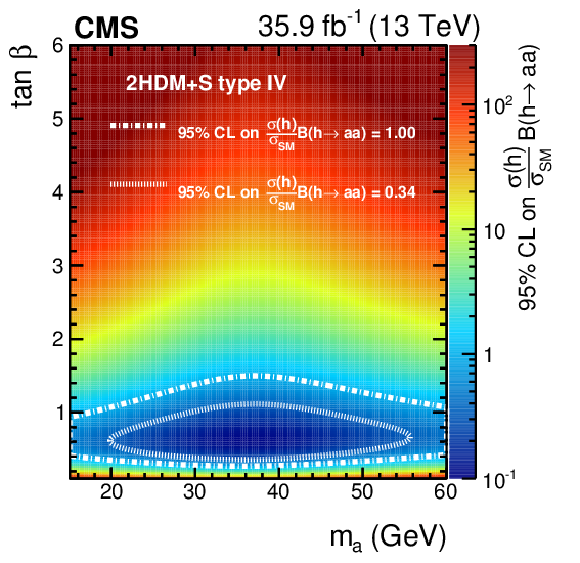
png pdf |
Figure 8-b:
Observed 95% CL limits on $(\sigma (\mathrm {h})/\sigma _\textrm {SM}){\mathcal {B}}({{\mathrm {h}}} \to {{\mathrm {a}}} {{\mathrm {a}}})$ in 2HDM+S of type IV. The contours corresponding to a 95% CL exclusion of $(\sigma (\mathrm {h})/\sigma _\textrm {SM}){\mathcal {B}}({\mathrm {h}} \to {{\mathrm {a}}} {{\mathrm {a}}})= $ 1.00 and 0.34 are drawn with dashed lines. The number 34% corresponds to the limit on the branching fraction of the Higgs boson to beyond-the-SM particles at the 95% CL obtained with data collected at center-of-mass energies of 7 and 8 TeV by the ATLAS and CMS experiments [10]. |
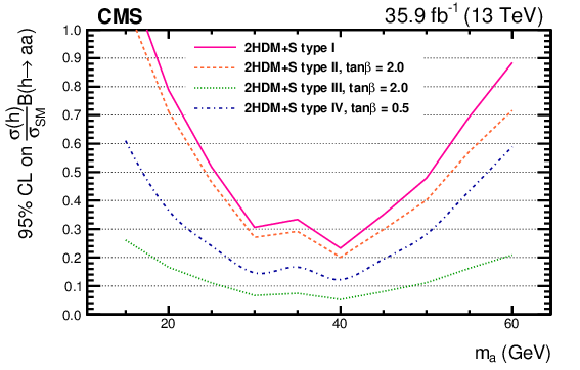
png pdf |
Figure 9:
Observed 95% CL limits on $(\sigma ({{\mathrm {h}}})/\sigma _\textrm {SM}){\mathcal {B}}({{\mathrm {h}}} \to {{\mathrm {a}}} {{\mathrm {a}}})$ for various 2HDM+S types. The limit in type I 2HDM+S does not depend on $\tan\beta $. |
| Tables | |

png pdf |
Table 1:
Baseline selection criteria for objects required in various final states. The numbers given for the ${p_{{\mathrm {T}}}}$ thresholds of the electron and muon in the $ \mathrm {e} {\mu}$ final state correspond to the leading and subleading particles. The ${p_{{\mathrm {T}}}}$ threshold for the $ \tau _{\mathrm {h}} $ candidates is the result of an optimization of the expected exclusion limits of the signal. |
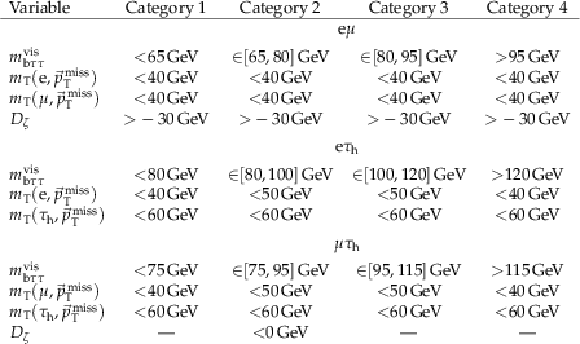
png pdf |
Table 2:
Optimized selection and categorization in the various final states. The selection criterion $D_\zeta > -30 $ GeV in the $ {{\mathrm {e}} {{\mu}}}$ final state reduces the large $ {{{\mathrm {t}\overline {{\mathrm {t}}}}}} $ background. In the the other final states the $ {{{\mathrm {t}\overline {{\mathrm {t}}}}}} $ background is less important, and only events with $D_\zeta > $ 0 GeV are discarded in one of the categories of the $ {{\mu}} {{\tau} _{\mathrm {h}}} $ final state to reduce the $ {{\mathrm {Z}} \to {\tau} {\tau}}$ background. This selection criterion does not improve the sensitivity in the $ {{\mathrm {e}} {{\tau} _{\mathrm {h}}}} $ final state because of the lower expected signal and background yields, and is therefore not applied. |
| Summary |
| The first search for exotic decays of the Higgs boson to pairs of light bosons with two b quark jets and two $\tau$ leptons in the final state has been performed with 35.9 fb$^{-1}$ of data collected at 13 TeV center-of-mass energy in 2016. This decay channel has a large branching fraction in many models where the couplings to fermions are proportional to the fermion mass, and can be triggered in the dominant gluon fusion production mode because of the presence of light leptons from leptonic $\tau$ decays. No excess of events is found on top of the expected standard model background for masses of the light boson, ${m_{\mathrm{a}}} $, between 15 and 60 GeV. Upper limits between 3 and 12% are set on the branching fraction ${\mathcal{B}({{{\mathrm{h}}\to{\mathrm{a}\mathrm{a}}\to2\tau2\mathrm{b}}})}$ assuming the SM production of the Higgs boson. This translates to upper limits on ${\mathcal{B}({\mathrm{h}\to\mathrm{a}\mathrm{a}}}$ as low as 20% for ${m_{\mathrm{a}}} = $ 40 GeV in the NMSSM. These results improve by more than one order of magnitude the sensitivity to exotic Higgs boson decays to pairs of light pseudoscalars in the NMSSM from previous CMS results in other final states for 15 $ < {m_{\mathrm{a}}} < $ 25 GeV, and by a factor up to five for 25 $ < {m_{\mathrm{a}}} < $ 60 GeV [28,31]. |
| Additional Figures | |
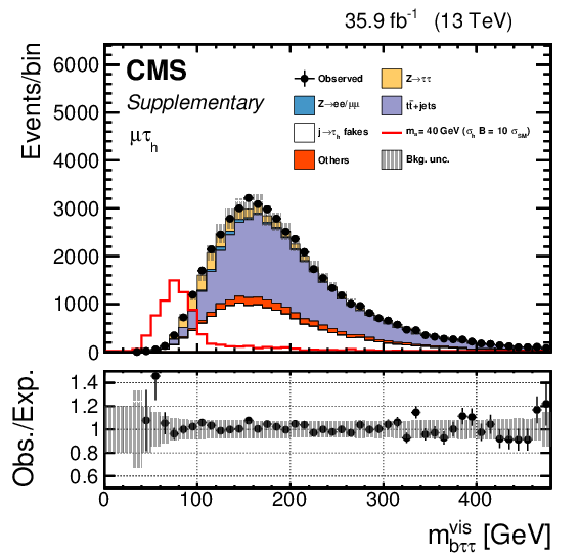
png pdf |
Additional Figure 1:
Distributions of $m_{{\mathrm {b}} {\tau} {\tau}}^{\mathrm {vis}}$ in the $ {{\mu}} {\tau}_{\rm h}$ channel before the categorization. The selection criteria based on $m_{\mathrm{T}}({{\mu}},{\vec{p}}_{\mathrm {T}}^{\,\text {miss}})$, $m_{\mathrm{T}}({\tau}_{\rm h},{\vec{p}}_{\mathrm {T}}^{\,\text {miss}})$, and $D_\zeta $ are not applied. The "jet$\rightarrow {\tau}_{\rm h}$" contribution includes all events with a jet misidentified as a $ {\tau}_{\rm h}$ candidate, whereas the other contributions only include events where the reconstructed $ {\tau}_{\rm h}$ corresponds to a $ {\tau}_{\rm h}$, a muon, or an electron, at generated level. The "Others" contribution includes events from single top quark, diboson, and SM Higgs boson productions. The signal for $m_{\mathrm {a}}= $ 40 GeV is scaled to a cross section times branching fraction equal to 10 times the production cross section of the Higgs boson in the SM. |
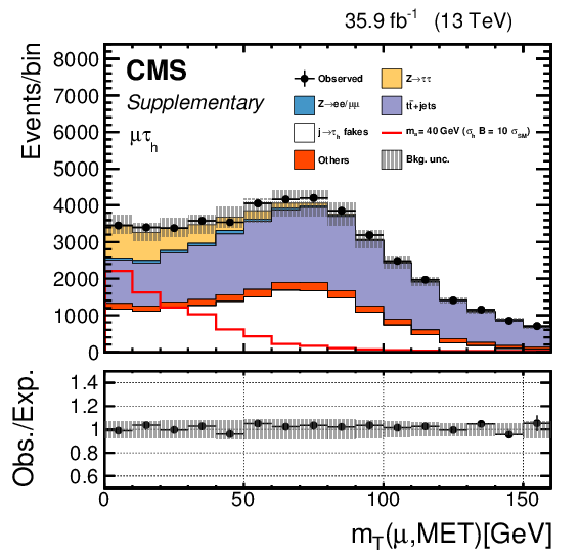
png pdf |
Additional Figure 2:
Distributions of $m_{\mathrm{T}}({{\mu}},{\vec{p}}_{\mathrm {T}}^{\,\text {miss}})$ in the $ {{\mu}} {\tau}_{\rm h}$ channel before the categorization. The selection criteria based on $m_{\mathrm{T}}({{\mu}},{\vec{p}}_{\mathrm {T}}^{\,\text {miss}})$, $m_{\mathrm{T}}({\tau}_{\rm h},{\vec{p}}_{\mathrm {T}}^{\,\text {miss}})$, and $D_\zeta $ are not applied. The "jet$\rightarrow {\tau}_{\rm h}$" contribution includes all events with a jet misidentified as a $ {\tau}_{\rm h}$ candidate, whereas the other contributions only include events where the reconstructed $ {\tau}_{\rm h}$ corresponds to a $ {\tau}_{\rm h}$, a muon, or an electron, at generated level. The "Others" contribution includes events from single top quark, diboson, and SM Higgs boson productions. The signal for $m_{\mathrm {a}}= $ 40 GeV is scaled to a cross section times branching fraction equal to 10 times the production cross section of the Higgs boson in the SM. |

png pdf |
Additional Figure 3:
Distributions of $m_{\mathrm{T}}({\tau}_{\rm h},{\vec{p}}_{\mathrm {T}}^{\,\text {miss}})$ in the $ {{\mu}} {\tau}_{\rm h}$ channel before the categorization. The selection criteria based on $m_{\mathrm{T}}({{\mu}},{\vec{p}}_{\mathrm {T}}^{\,\text {miss}})$, $m_{\mathrm{T}}({\tau}_{\rm h},{\vec{p}}_{\mathrm {T}}^{\,\text {miss}})$, and $D_\zeta $ are not applied. The "jet$\rightarrow {\tau}_{\rm h}$" contribution includes all events with a jet misidentified as a $ {\tau}_{\rm h}$ candidate, whereas the other contributions only include events where the reconstructed $ {\tau}_{\rm h}$ corresponds to a $ {\tau}_{\rm h}$, a muon, or an electron, at generated level. The "Others" contribution includes events from single top quark, diboson, and SM Higgs boson productions. The signal for $m_{\mathrm {a}}= $ 40 GeV is scaled to a cross section times branching fraction equal to 10 times the production cross section of the Higgs boson in the SM. |
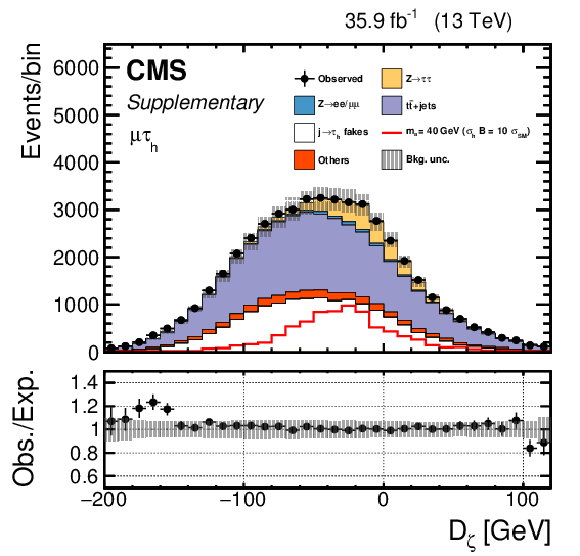
png pdf |
Additional Figure 4:
Distributions of $D_\zeta $ in the $ {{\mu}} {\tau}_{\rm h}$ channel before the categorization. The selection criteria based on $m_{\mathrm{T}}({{\mu}},{\vec{p}}_{\mathrm {T}}^{\,\text {miss}})$, $m_{\mathrm{T}}({\tau}_{\rm h},{\vec{p}}_{\mathrm {T}}^{\,\text {miss}})$, and $D_\zeta $ are not applied. The "jet$\rightarrow {\tau}_{\rm h}$" contribution includes all events with a jet misidentified as a $ {\tau}_{\rm h}$ candidate, whereas the other contributions only include events where the reconstructed $ {\tau}_{\rm h}$ corresponds to a $ {\tau}_{\rm h}$, a muon, or an electron, at generated level. The "Others" contribution includes events from single top quark, diboson, and SM Higgs boson productions. The signal for $m_{\mathrm {a}}= $ 40 GeV is scaled to a cross section times branching fraction equal to 10 times the production cross section of the Higgs boson in the SM. |

png pdf |
Additional Figure 5:
Distributions of $m_{{\mathrm {b}} {\tau} {\tau}}^{\mathrm {vis}}$ in the $ {\mathrm {e}} {\tau}_{\rm h}$ channel before the categorization. The selection criteria based on $m_{\mathrm{T}}({\mathrm {e}},{\vec{p}}_{\mathrm {T}}^{\,\text {miss}})$, $m_{\mathrm{T}}({\tau}_{\rm h},{\vec{p}}_{\mathrm {T}}^{\,\text {miss}})$, and $D_\zeta $ are not applied. The "jet$\rightarrow {\tau}_{\rm h}$" contribution includes all events with a jet misidentified as a $ {\tau}_{\rm h}$ candidate, whereas the other contributions only include events where the reconstructed $ {\tau}_{\rm h}$ corresponds to a $ {\tau}_{\rm h}$, a muon, or an electron, at generated level. The "Others" contribution includes events from single top quark, diboson, and SM Higgs boson productions. The signal for $m_{\mathrm {a}}= $ 40 GeV is scaled to a cross section times branching fraction equal to 10 times the production cross section of the Higgs boson in the SM. |
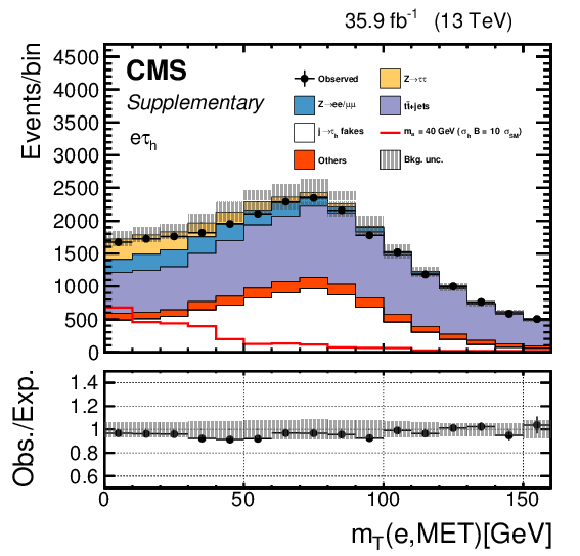
png pdf |
Additional Figure 6:
Distributions of $m_{\mathrm{T}}({\mathrm {e}},{\vec{p}}_{\mathrm {T}}^{\,\text {miss}})$ in the $ {\mathrm {e}} {\tau}_{\rm h}$ channel before the categorization. The selection criteria based on $m_{\mathrm{T}}({\mathrm {e}},{\vec{p}}_{\mathrm {T}}^{\,\text {miss}})$, $m_{\mathrm{T}}({\tau}_{\rm h},{\vec{p}}_{\mathrm {T}}^{\,\text {miss}})$, and $D_\zeta $ are not applied. The "jet$\rightarrow {\tau}_{\rm h}$" contribution includes all events with a jet misidentified as a $ {\tau}_{\rm h}$ candidate, whereas the other contributions only include events where the reconstructed $ {\tau}_{\rm h}$ corresponds to a $ {\tau}_{\rm h}$, a muon, or an electron, at generated level. The "Others" contribution includes events from single top quark, diboson, and SM Higgs boson productions. The signal for $m_{\mathrm {a}}= $ 40 GeV is scaled to a cross section times branching fraction equal to 10 times the production cross section of the Higgs boson in the SM. |

png pdf |
Additional Figure 7:
Distributions of $m_{\mathrm{T}}({\tau}_{\rm h},{\vec{p}}_{\mathrm {T}}^{\,\text {miss}})$ in the $ {\mathrm {e}} {\tau}_{\rm h}$ channel before the categorization. The selection criteria based on $m_{\mathrm{T}}({\mathrm {e}},{\vec{p}}_{\mathrm {T}}^{\,\text {miss}})$, $m_{\mathrm{T}}({\tau}_{\rm h},{\vec{p}}_{\mathrm {T}}^{\,\text {miss}})$, and $D_\zeta $ are not applied. The "jet$\rightarrow {\tau}_{\rm h}$" contribution includes all events with a jet misidentified as a $ {\tau}_{\rm h}$ candidate, whereas the other contributions only include events where the reconstructed $ {\tau}_{\rm h}$ corresponds to a $ {\tau}_{\rm h}$, a muon, or an electron, at generated level. The "Others" contribution includes events from single top quark, diboson, and SM Higgs boson productions. The signal for $m_{\mathrm {a}}= $ 40 GeV is scaled to a cross section times branching fraction equal to 10 times the production cross section of the Higgs boson in the SM. |
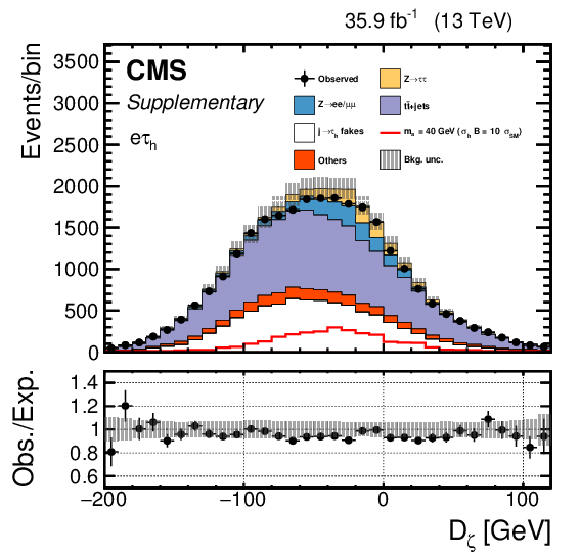
png pdf |
Additional Figure 8:
Distributions of $D_\zeta $ in the $ {\mathrm {e}} {\tau}_{\rm h}$ channel before the categorization. The selection criteria based on $m_{\mathrm{T}}({\mathrm {e}},{\vec{p}}_{\mathrm {T}}^{\,\text {miss}})$, $m_{\mathrm{T}}({\tau}_{\rm h},{\vec{p}}_{\mathrm {T}}^{\,\text {miss}})$, and $D_\zeta $ are not applied. The "jet$\rightarrow {\tau}_{\rm h}$" contribution includes all events with a jet misidentified as a $ {\tau}_{\rm h}$ candidate, whereas the other contributions only include events where the reconstructed $ {\tau}_{\rm h}$ corresponds to a $ {\tau}_{\rm h}$, a muon, or an electron, at generated level. The "Others" contribution includes events from single top quark, diboson, and SM Higgs boson productions. The signal for $m_{\mathrm {a}}= $ 40 GeV is scaled to a cross section times branching fraction equal to 10 times the production cross section of the Higgs boson in the SM. |
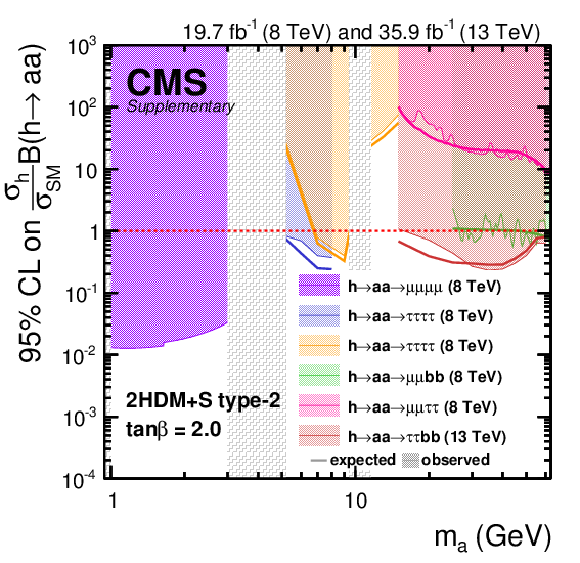
png pdf |
Additional Figure 9:
Expected and observed 95% CL limits on $({\sigma _h}/{\sigma _{\textrm {SM}}})\mathcal {B}(\textrm {h}\rightarrow \textrm {aa})$ 2HDM+S type II $\tan\beta =2$. Limits are shown as a function of the mass of the light boson, $\textrm {m}_\textrm {a}$. The branching fractions of the pseudoscalar boson to SM particles are computed following a model described in arXiv:1312.4992. Grey shaded regions correspond to regions where theoretical predictions for the branching fractions of the pseudoscalar boson to SM particles are not reliable. The limits for the bb$\tau \tau $ channel were obtained using an integrated luminosity of 35.9 fb$^{-1}$ collected at 13 TeV center-of-mass energy, while the other results were obtained using an integrated luminosity of 19.7 fb$^{-1}$ collected at 8 TeV center-of-mass energy [28] (arXiv:1701.02032). |
| References | ||||
| 1 | F. Englert and R. Brout | Broken symmetry and the mass of gauge vector mesons | PRL 13 (1964) 321 | |
| 2 | P. W. Higgs | Broken symmetries, massless particles and gauge fields | PL12 (1964) 132 | |
| 3 | P. W. Higgs | Broken symmetries and the masses of gauge bosons | PRL 13 (1964) 508 | |
| 4 | G. S. Guralnik, C. R. Hagen, and T. W. B. Kibble | Global conservation laws and massless particles | PRL 13 (1964) 585 | |
| 5 | P. W. Higgs | Spontaneous symmetry breakdown without massless bosons | PR145 (1966) 1156 | |
| 6 | T. W. B. Kibble | Symmetry breaking in non-Abelian gauge theories | PR155 (1967) 1554 | |
| 7 | ATLAS Collaboration | Observation of a new particle in the search for the standard model Higgs boson with the ATLAS detector at the LHC | PLB 716 (2012) 1 | 1207.7214 |
| 8 | CMS Collaboration | Observation of a new boson at a mass of 125 GeV with the CMS experiment at the LHC | PLB 716 (2012) 30 | CMS-HIG-12-028 1207.7235 |
| 9 | CMS Collaboration | Observation of a new boson with mass near 125 GeV in pp collisions at $ \sqrt{s}= $ 7 and 8 TeV | JHEP 06 (2013) 081 | CMS-HIG-12-036 1303.4571 |
| 10 | ATLAS and CMS Collaborations | Measurements of the Higgs boson production and decay rates and constraints on its couplings from a combined ATLAS and CMS analysis of the LHC pp collision data at $ \sqrt{s}= $ 7 and 8 TeV | JHEP 08 (2016) 045 | 1606.02266 |
| 11 | B. A. Dobrescu, G. L. Landsberg, and K. T. Matchev | Higgs boson decays to CP odd scalars at the Tevatron and beyond | PRD 63 (2001) 075003 | hep-ph/0005308 |
| 12 | R. Dermisek and J. F. Gunion | Escaping the large fine tuning and little hierarchy problems in the next to minimal supersymmetric model and $ \textrm{h}\rightarrow\textrm{aa} $ decays | PRL 95 (2005) 041801 | hep-ph/0502105 |
| 13 | R. Dermisek and J. F. Gunion | The NMSSM close to the R-symmetry limit and naturalness in $ \textrm{h} \rightarrow \textrm{aa} $ decays for $ m_a < 2 m_b $ | PRD 75 (2007) 075019 | hep-ph/0611142 |
| 14 | S. Chang, R. Dermisek, J. F. Gunion, and N. Weiner | Nonstandard Higgs boson decays | Ann. Rev. Nucl. Part. Sci. 58 (2008) 75 | 0801.4554 |
| 15 | D. Curtin et al. | Exotic decays of the 125 GeV Higgs boson | PRD 90 (2014) 075004 | 1312.4992 |
| 16 | J. A. Evans, S. Gori, and J. Shelton | Looking for the WIMP next door | JHEP 02 (2018) 100 | 1712.03974 |
| 17 | C. Englert, T. Plehn, D. Zerwas, and P. M. Zerwas | Exploring the Higgs portal | PLB 703 (2011) 298 | 1106.3097 |
| 18 | B. Dumont, J. F. Gunion, Y. Jiang, and S. Kraml | Constraints on and future prospects for two-Higgs-doublet models in light of the LHC Higgs signal | PRD 90 (2014) 035021 | 1405.3584 |
| 19 | CMS Collaboration | Search for neutral MSSM Higgs bosons decaying to a pair of tau leptons in pp collisions | JHEP 10 (2014) 160 | CMS-HIG-13-021 1408.3316 |
| 20 | CMS Collaboration | Search for neutral MSSM Higgs bosons decaying into a pair of bottom quarks | JHEP 11 (2015) 071 | CMS-HIG-14-017 1506.08329 |
| 21 | CMS Collaboration | Search for neutral MSSM higgs bosons decaying to $ \mu^{+} \mu^{-} $ in pp collisions at $ \sqrt{s} = $ 7 and 8 TeV | PLB 752 (2016) 221 | CMS-HIG-13-024 1508.01437 |
| 22 | CMS Collaboration | Search for a charged Higgs boson in pp collisions at $ \sqrt{s}= $ 8 TeV | JHEP 11 (2015) 018 | CMS-HIG-14-023 1508.07774 |
| 23 | CMS Collaboration | Search for Higgs boson pair production in events with two bottom quarks and two tau leptons in proton-proton collisions at $ \sqrt s = $ 13 TeV | PLB 778 (2018) 101 | CMS-HIG-17-002 1707.02909 |
| 24 | CMS Collaboration | Searches for a heavy scalar boson H decaying to a pair of 125 GeV Higgs bosons hh or for a heavy pseudoscalar boson A decaying to $ z $h, in the final states with h$ \to\tau \tau $ | PLB 755 (2016) 217 | CMS-HIG-14-034 1510.01181 |
| 25 | S. Heinemeyer, O. Stal, and G. Weiglein | Interpreting the LHC Higgs search results in the MSSM | PLB 710 (2012) 201 | 1112.3026 |
| 26 | G. C. Branco et al. | Theory and phenomenology of two-Higgs-doublet models | Phys. Rep. 516 (2012) 1 | 1106.0034 |
| 27 | S. Ramos-Sanchez | The mu-problem, the NMSSM and string theory | Fortsch. Phys. 58 (2010) 748 | 1003.1307 |
| 28 | CMS Collaboration | Search for light bosons in decays of the 125 GeV Higgs boson in proton-proton collisions at $ \sqrt{s}= $ 8 TeV | JHEP 10 (2017) 076 | CMS-HIG-16-015 1701.02032 |
| 29 | CMS Collaboration | Search for a very light NMSSM Higgs boson produced in decays of the 125 GeV scalar boson and decaying into $ \tau $ leptons in pp collisions at $ \sqrt{s}= $ 8 TeV | JHEP 01 (2016) 079 | CMS-HIG-14-019 1510.06534 |
| 30 | CMS Collaboration | A search for pair production of new light bosons decaying into muons | PLB 752 (2016) 146 | CMS-HIG-13-010 1506.00424 |
| 31 | CMS Collaboration | Search for an exotic decay of the Higgs boson to a pair of light pseudoscalars in the final state of two muons and two $ \tau $ leptons in proton-proton collisions at $ \sqrt{s}= $ 13 TeV | Submitted to JHEP | CMS-HIG-17-029 1805.04865 |
| 32 | ATLAS Collaboration | Search for new light gauge bosons in Higgs boson decays to four-lepton final states in pp collisions at $ \sqrt{s}= $ 8 TeV with the ATLAS detector at the LHC | PRD 92 (2015) 092001 | 1505.07645 |
| 33 | ATLAS Collaboration | Search for new phenomena in events with at least three photons collected in pp collisions at $ \sqrt{s} = $ 8 TeV with the ATLAS detector | EPJC 76 (2016) 210 | 1509.05051 |
| 34 | ATLAS Collaboration | Search for Higgs bosons decaying to aa in the $ \mu\mu\tau\tau $ final state in pp collisions at $ \sqrt{s} = $ 8 TeV with the ATLAS experiment | PRD 92 (2015) 052002 | 1505.01609 |
| 35 | ATLAS Collaboration | Search for the Higgs boson produced in association with a W boson and decaying to four b-quarks via two spin-zero particles in pp collisions at 13 TeV with the ATLAS detector | EPJC 76 (2016) 605 | 1606.08391 |
| 36 | ATLAS Collaboration | Search for Higgs boson decays to beyond-the-standard-model light bosons in four-lepton events with the ATLAS detector at $ \sqrt{s}= $ 13 TeV | Submitted to JHEP | 1802.03388 |
| 37 | CMS Collaboration | The CMS trigger system | JINST 12 (2017) P01020 | CMS-TRG-12-001 1609.02366 |
| 38 | CMS Collaboration | The CMS experiment at the CERN LHC | JINST 3 (2008) S08004 | CMS-00-001 |
| 39 | J. Alwall et al. | The automated computation of tree-level and next-to-leading order differential cross sections, and their matching to parton shower simulations | JHEP 07 (2014) 079 | 1405.0301 |
| 40 | J. Alwall et al. | Comparative study of various algorithms for the merging of parton showers and matrix elements in hadronic collisions | EPJC 53 (2008) 473 | 0706.2569 |
| 41 | R. Frederix and S. Frixione | Merging meets matching in MC@NLO | JHEP 12 (2012) 061 | 1209.6215 |
| 42 | P. Nason | A new method for combining NLO QCD with shower Monte Carlo algorithms | JHEP 11 (2004) 040 | hep-ph/0409146 |
| 43 | S. Frixione, P. Nason, and C. Oleari | Matching NLO QCD computations with parton shower simulations: the POWHEG method | JHEP 11 (2007) 070 | 0709.2092 |
| 44 | S. Alioli, P. Nason, C. Oleari, and E. Re | A general framework for implementing NLO calculations in shower Monte Carlo programs: the POWHEG BOX | JHEP 06 (2010) 043 | 1002.2581 |
| 45 | S. Alioli et al. | Jet pair production in POWHEG | JHEP 04 (2011) 081 | 1012.3380 |
| 46 | S. Alioli, P. Nason, C. Oleari, and E. Re | NLO Higgs boson production via gluon fusion matched with shower in POWHEG | JHEP 04 (2009) 002 | 0812.0578 |
| 47 | S. Frixione, P. Nason, and G. Ridolfi | A positive-weight next-to-leading-order Monte Carlo for heavy flavour hadroproduction | JHEP 09 (2007) 126 | 0707.3088 |
| 48 | E. Bagnaschi, G. Degrassi, P. Slavich, and A. Vicini | Higgs production via gluon fusion in the POWHEG approach in the SM and in the MSSM | JHEP 02 (2012) 088 | 1111.2854 |
| 49 | G. Luisoni, P. Nason, C. Oleari, and F. Tramontano | HW$ ^{\pm} $/HZ+0 and 1 jet at NLO with the POWHEG BOX interfaced to GoSam and their merging within MiNLO | JHEP 10 (2013) 083 | 1306.2542 |
| 50 | T. Sjostrand et al. | An introduction to PYTHIA 8.2 | CPC 191 (2015) 159 | 1410.3012 |
| 51 | CMS Collaboration | Event generator tunes obtained from underlying event and multiparton scattering measurements | EPJC 76 (2016) 155 | CMS-GEN-14-001 1512.00815 |
| 52 | NNPDF Collaboration | Parton distributions for the LHC Run II | JHEP 04 (2015) 040 | 1410.8849 |
| 53 | M. Beneke, P. Falgari, S. Klein, and C. Schwinn | Hadronic top-quark pair production with NNLL threshold resummation | NPB 855 (2012) 695 | 1109.1536 |
| 54 | M. Cacciari et al. | Top-pair production at hadron colliders with next-to-next-to-leading logarithmic soft-gluon resummation | PLB 710 (2012) 612 | 1111.5869 |
| 55 | P. Baernreuther, M. Czakon, and A. Mitov | Percent level precision physics at the tevatron: First genuine NNLO QCD corrections to $ \mathrm{ q \bar{q} } \to \mathrm{t\bar{t}} + X $ | PRL 109 (2012) 132001 | 1204.5201 |
| 56 | M. Czakon and A. Mitov | NNLO corrections to top pair production at hadron colliders: the quark-gluon reaction | JHEP 01 (2013) 080 | 1210.6832 |
| 57 | M. Czakon and A. Mitov | NNLO corrections to top-pair production at hadron colliders: the all-fermionic scattering channels | JHEP 12 (2012) 054 | 1207.0236 |
| 58 | M. Czakon, P. Fiedler, and A. Mitov | Total top-quark pair-production cross section at hadron colliders through O($ \alpha_s^4 $) | PRL 110 (2013) 252004 | 1303.6254 |
| 59 | M. Czakon and A. Mitov | Top++: A program for the calculation of the top-pair cross-section at hadron colliders | CPC 185 (2014) 2930 | 1112.5675 |
| 60 | GEANT4 Collaboration | GEANT4--a simulation toolkit | NIMA 506 (2003) 250 | |
| 61 | CMS Collaboration | Particle-flow reconstruction and global event description with the CMS detector | JINST 12 (2017) P10003 | CMS-PRF-14-001 1706.04965 |
| 62 | CMS Collaboration | Performance of electron reconstruction and selection with the CMS detector in proton-proton collisions at $ \sqrt{s} = $ 8 TeV | JINST 10 (2015) P06005 | CMS-EGM-13-001 1502.02701 |
| 63 | CMS Collaboration | Performance of CMS muon reconstruction in pp collision events at $ \sqrt{s}= $ 7 TeV | JINST 7 (2012) P10002 | CMS-MUO-10-004 1206.4071 |
| 64 | M. Cacciari, G. P. Salam, and G. Soyez | FastJet user manual | EPJC 72 (2012) 1896 | 1111.6097 |
| 65 | M. Cacciari and G. P. Salam | Dispelling the $ N^{3} $ myth for the $ {k_{\mathrm{T}}} $ jet-finder | PLB 641 (2006) 57 | hep-ph/0512210 |
| 66 | CMS Collaboration | Determination of jet energy calibration and transverse momentum resolution in CMS | JINST 6 (2011) 11002 | CMS-JME-10-011 1107.4277 |
| 67 | CMS Collaboration | Identification of heavy-flavour jets with the CMS detector in pp collisions at 13 TeV | JINST (2017) | CMS-BTV-16-002 1712.07158 |
| 68 | CMS Collaboration | Reconstruction and identification of $ \tau $ lepton decays to hadrons and $ \nu_\tau $ at CMS | JINST 11 (2016) P01019 | CMS-TAU-14-001 1510.07488 |
| 69 | CMS Collaboration | Performance of reconstruction and identification of tau leptons in their decays to hadrons and tau neutrino in LHC Run-2 | CMS-PAS-TAU-16-002 | CMS-PAS-TAU-16-002 |
| 70 | M. Cacciari, G. P. Salam, and G. Soyez | The anti-$ {k_{\mathrm{T}}} $ jet clustering algorithm | JHEP 04 (2008) 063 | 0802.1189 |
| 71 | CMS Collaboration | Observation of the Higgs boson decay to a pair of $ \tau $ leptons with the CMS detector | PLB 779 (2018) 283 | CMS-HIG-16-043 1708.00373 |
| 72 | J. S. Conway | Incorporating nuisance parameters in likelihoods for multisource spectra | in Proceedings of PHYSTAT 2011 Workshop on Statistical Issues Related to Discovery Claims in Search Experiments and Unfolding, p. 115 CERN-2011-006 | |
| 73 | CMS Collaboration | Performance of the CMS missing transverse momentum reconstruction in pp data at $ \sqrt{s} = $ 8 TeV | JINST 10 (2015) P02006 | CMS-JME-13-003 1411.0511 |
| 74 | CMS Collaboration | Measurement of the inclusive W and Z production cross sections in pp collisions at $ \sqrt{s}= $ 7 TeV | JHEP 10 (2011) 132 | CMS-EWK-10-005 1107.4789 |
| 75 | CMS Collaboration | Measurements of the $ \mathrm {p}\mathrm {p}\rightarrow \mathrm{Z}\mathrm{Z} $ production cross section and the $ \mathrm{Z}\rightarrow 4\ell $ branching fraction, and constraints on anomalous triple gauge couplings at $ \sqrt{s} = $ 13 TeV | EPJC 78 (2018) 165 | CMS-SMP-16-017 1709.08601 |
| 76 | CMS Collaboration | Cross section measurement of t-channel single top quark production in pp collisions at $ \sqrt s = $ 13 TeV | PLB 772 (2017) 752 | CMS-TOP-16-003 1610.00678 |
| 77 | CMS Collaboration | Measurements of the associated production of a Z boson and b jets in pp collisions at $ \sqrt{s} = $ 8 TeV | EPJC 77 (2017) 751 | CMS-SMP-14-010 1611.06507 |
| 78 | D. de Florian et al. | Handbook of LHC Higgs cross sections: 4. Deciphering the nature of the Higgs sector | CERN-2017-002-M | 1610.07922 |
| 79 | CMS Collaboration | CMS luminosity measurements for the 2016 data taking period | CMS-PAS-LUM-17-001 | CMS-PAS-LUM-17-001 |
| 80 | The ATLAS Collaboration, The CMS Collaboration, The LHC Higgs Combination Group | Procedure for the LHC Higgs boson search combination in Summer 2011 | CMS-NOTE-2011-005 | |
| 81 | CMS Collaboration | Combined results of searches for the standard model Higgs boson in pp collisions at $ \sqrt{s}= $ 7 TeV | PLB 710 (2012) 26 | CMS-HIG-11-032 1202.1488 |
| 82 | T. Junk | Confidence level computation for combining searches with small statistics | NIMA 434 (1999) 435 | hep-ex/9902006 |
| 83 | A. L. Read | Presentation of search results: the $ CL_s $ technique | in Durham IPPP Workshop: Advanced Statistical Techniques in Particle Physics, p. 2693 Durham, UK, March, 2002 [JPG 28 (2002) 2693] | |
| 84 | G. Cowan, K. Cranmer, E. Gross, and O. Vitells | Asymptotic formulae for likelihood-based tests of new physics | EPJC 71 (2011) 1554 | 1007.1727 |
| 85 | A. Djouadi | The anatomy of electro-weak symmetry breaking. I: the Higgs boson in the standard model | Phys. Rep. 457 (2008) 1 | hep-ph/0503172 |

|
Compact Muon Solenoid LHC, CERN |

|

|

|

|

|

|